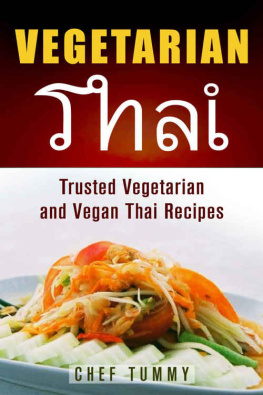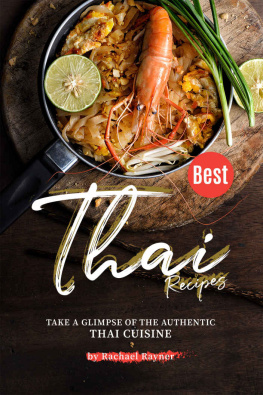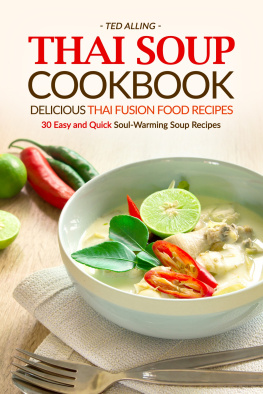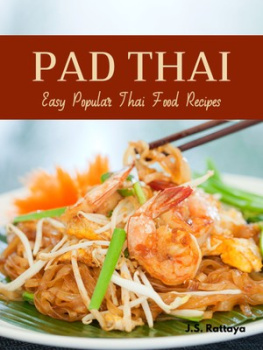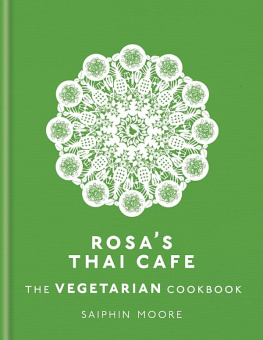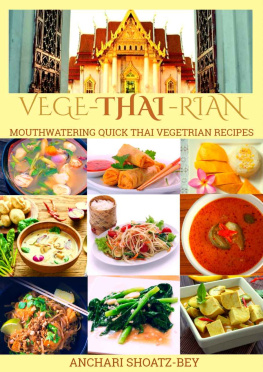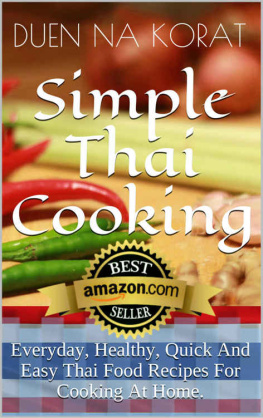INTRODUCTION
Thai cooking offers a delicious variety of vibrant flavors, exciting colors, perfumed smells and satisfying textures for any one seeking inspired vegetarian eating. When eating Thai food, the mouth, the eyes and the nose do a dance like a combination of the limbo and the tango.
Thai cooks and eaters highly value vegetables and fruits as they are available all year long, right from the family garden, nearby fruit trees, the many fresh markets or plucked from bushes by the side of the road.
The Thai dietary practice of enjoying a variety of these fresh foods combined with quick cooking techniques lends itself to making the freshest and most flavorful vegetarian food. Vegetarian cooking, with its gentle treatment of the Earth, is especially revered by Thailand s followers of Buddhism.
Where Do The Recipes Come From?
These recipes were collected over a nine-year period when I lived in Thailand. During that time, I first went to Thai language school so I could speak and read at a basic level, and later attended several professional Thai cooking classes.
Then I went directly to the source to feed my curiosity about Thai food.
I decided to leap before I looked I went on an ultimate food journey, learning to cook from the real experts the awesome Aunties and Uncles who make traditional Thai food in their homes and family restaurants.
I took a 6,002-mile motorcycle trek all around the county to learn how to cook authentic Thai food. I wanted to really understand the ingredients and what cooking techniques would make the best tasting Thai dishes.
I went from the top to the bottom and from side to side in Thailand (a country about the same size as Germany or Italy) on a banana-yellow Honda 125-cc motorcycle for eight months during 2007-2008. Every where I went I was able to learn about Thai cooking from generous cooks who let me watch and help them make memorable meals. I learned the key to Thai cooking is the skillful combination of fresh ingredients with simple techniques that coax out the true flavors. I learned an enormous variety of vegetarian recipes during this trip and the many trips I have taken since. I also taught vegetarian Thai cooking at my Thai cooking school and these recipes were the favorites from my students from over 30 countries.
Thailand Is A Paradise For Vegetarian Eaters
Shopping and cooking in Thailand is a paradise for vegetarians. The sheer variety of vegetables and fruits in a typical Thai market is staggering row after row of bright red and green chiles, sprawling vegetable displays with five types of eggplant, three types of basil, and bucket after bucket of fresh mint, lemongrass, cilantro, plus stacks of oranges, dragon fruit, bananas, pomelos, watermelons, and a dozen other fruits.
These recipes have been adapted from traditional Thai family recipes. Where Thai cooking uses fish sauce and fermented shrimp paste to add salt to dishes, we have substituted soy sauce. Please see the next section for tips and techniques on how to select and prepare these vegetarian ingredients.
We will teach you how to select the right ingredients to make memorable meals at home and make your food taste authentically delicious. Choosy cooks choose carefully and we will guide you to the right choices.
Enjoy this collection of Thai vegetarian recipes and please see our website for new recipes.
The website is www.cheftummy.com .
YOUR HOW TO GUIDE TO MAKING TASTY AND AUTHENTIC THAI VEGETARIAN FOOD
Here are some suggestions on what ingredients to use, substitutions for hard to find ingredients, plus some cooking tips and techniques.
Many commercially made Thai curry pastes are not strictly vegetarian since they contain a type of fermented shrimp. Included in this cookbook are recipes for red, green and Massaman style curry paste that have no shrimp or other animal products. These pastes are easy to make at home and the paste can be stored in the refrigerator or freezer with great success.
Vegetable oil is best for Thai stir-fried dishes, never olive oil. Since Thai food gets most of its flavor from a spicy sauce, an intense curry paste or other strong ingredients, the neutral taste of vegetable oil is preferred to the fruity taste of olive oil. You can use vegetable oil or canola oil or other nut oils as you prefer.
Cilantro and coriander are the same herb. The seeds are usually called coriander seeds (we see these seeds in the curry paste recipes).
Italian parsley is not a substitute for cilantro. Ever. They resemble each other but they don t taste the same.
The flavor in the cilantro plant is concentrated in the roots and stems, not the leaves. If you can buy cilantro with the roots intact, do so. Once you rinse off any dirt and trim off the root tendrils, you are in flavor city (cilantro stems and roots are the basis for the highly treasured and revered Three Buddies cilantro pesto paste recipe in this cookbook). The leaves are used for color and as a garnish in Thai dishes, rather than the basis of cilantro flavor for the dish.
Thai cooking primarily relies on two chiles: the small but potent Thai bird s eye chile and the larger, longer, less spicy Thai sky-pointing chile fruit (all chiles and all things with seeds are technically fruits, as you know, Chef!). If these are not available in your market, we have included specific chile substitutes and their appropriate quantities in the recipes.
When adding strong flavors such as chiles or soy sauce, it is easier to add than subtract. So add a little of the flavoring at a time and taste to see if you need more.
If you have accidentally made a dish too spicy, you can reduce the spice by adding sugar or honey.
Thai eaters eat rice with each spoonful of food, so the food is often highly spiced to serve as a counterpoint to the bland rice. You may adjust any dish to your own level of spice tolerance as eaters in Thailand also do.
The serving sizes in this cookbook suggest how much food the recipe makes in terms of eating a multi-dish Thai meal. Thai eaters like to enjoy several small portions of various foods, plus rice. If you are going to make a recipe as a standalone dish, you will have to recalculate the number of servings from each recipe.
The hardy coconut palm tree can be found all over Thailand s central and southern provinces. The white meat inside is used to make coconut cream for cooking. If you do not have access to fresh coconut, we recommend coconut cream from a can as the thicker cream has a more luxurious taste relative to coconut milk. Beware of using coconut cream intended for making sweet cocktails like Pina Coladas the added sugar in these types of coconut cream is unnecessary. So look for brands of coconut cream that have no added sugar. Reliable Thai brands include Chao Koh, Mae Ploy and Aroy-D.
Tofu for these recipes should be the firm type, not soft. The type of tofu we want is alternatively labelled firm or extra firm or hard tofu on the package. We use the firmest tofu so we can add it to soups or stir-fry it without it falling apart. We do not use the soft type tofu as it disintegrates when subjected to stir-frying. Typically, the tofu we use is sold in 14-ounce containers. Each 14-ounce container has roughly 4 cups of tofu.
When the recipe directs you to stir-fry, this means moving your spatula under the food and flipping it in the pan so the ingredients come in contact with the hot pan, and with each other. Since the amount of heat in your cooking pan will vary according to the heat your stove generates and the thickness of the pan you use, please pay careful attention when stir-frying so the food is moved frequently and does not burn.

